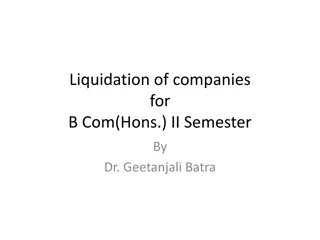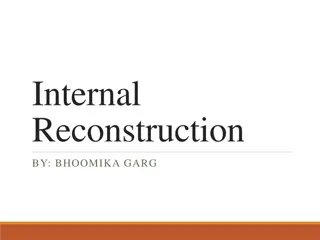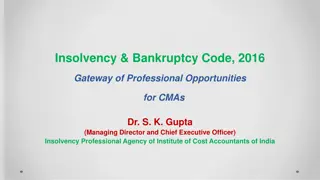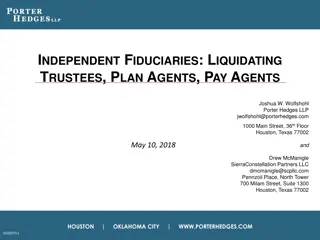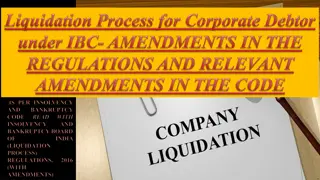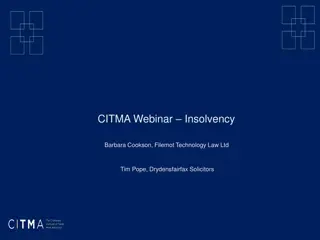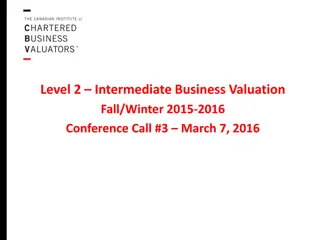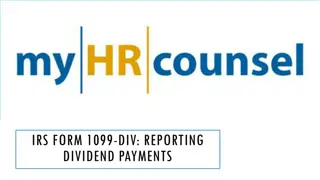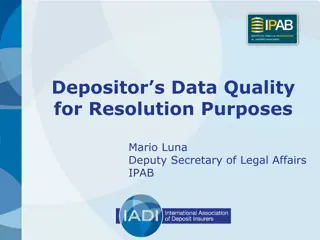Company Reconstruction and Capital Alteration Overview
Company reconstruction involves internal and external methods to reorganize the financial structure without liquidation or by forming a new company after liquidating the existing one. Objectives include writing off losses, adjusting share values, ensuring fair returns, and enhancing goodwill. Capita
1 views • 8 slides
EANS-I Grant Deadlines and Requirements Overview
Understanding the EANS-I grant deadlines is crucial for proper utilization of funds. Learn about the obligation, performance, and liquidation deadlines, including flexibility and requirements for reimbursement and direct payments. Stay informed to ensure compliance with the grant program guidelines.
2 views • 14 slides
Premier Liquidation Warehouse in Arizona
Find amazing deals on top brands at Vendorsoutlet.com, the ultimate liquidation warehouse in Arizona. Shop now and save big on your favorite items!\n\n\/\/ \/
4 views • 1 slides
Types of Shares: Ordinary and Preference Shares in Equity Investments
Equity capital in a company is comprised of ordinary and preference shares. Ordinary shares represent full risk and reward for shareholders, who can vote on resolutions and receive dividends. Preference shares offer specific features like cumulative or participating dividends, non-voting rights, and
0 views • 4 slides
Liquidation of Companies: Procedures as per IBC 2016
The process of liquidating a company involves collecting and selling its assets to pay off debts, with remaining funds distributed to shareholders. Under the Insolvency and Bankruptcy Code (IBC) 2016, specific procedures must be followed, including initiation by either creditors or debtors within se
0 views • 16 slides
Understanding Internal Reconstruction in Companies
Internal reconstruction in companies involves reorganizing the financial position without liquidation or forming a new entity. It aims to enhance profitability by aligning assets with true values. Methods include altering share capital, changing shareholder rights, and compromising with creditors. N
0 views • 19 slides
Understanding Insolvency Accounts and Laws in Financial Accounting
Insolvency in financial accounting refers to the inability to pay debts when they fall due. This article covers the meaning of insolvency, the criteria for being declared insolvent, the Insolvency Act in India, and its applicability to individuals, firms, and Hindu Undivided Families. It distinguish
1 views • 10 slides
Understanding Redemption of Preference Shares in Companies
Preference shares in companies offer preferential rights in dividend payments and capital repayment during liquidation. Redemption of preference shares involves returning the preference share capital to the shareholders. This process requires adherence to specific provisions under the Companies Act,
0 views • 25 slides
Understanding the Insolvency and Bankruptcy Code of 2016 in India
The Insolvency and Bankruptcy Code of 2016 in India replaced various existing laws to streamline the process of corporate restructuring, insolvency, and liquidation. Enacted to resolve bad debts efficiently, attract investors, and strengthen the economy, the code offers benefits like quicker resolut
0 views • 31 slides
Comprehensive Guide to Post-Confirmation Trusts and Plan Agents
Learn about the importance and necessity of post-confirmation trusts and plan agents in bankruptcy cases, the selection process for trustees/fiduciaries, choosing the right post-confirmation vehicle, creating trusts through agreements, and understanding the role of litigation/liquidation trusts in m
0 views • 32 slides
Understanding Liquidation Estate and Key Asset Components
In the process of liquidation, the liquidator forms an estate comprising various assets of the corporate debtor for the benefit of creditors. These assets include ownership rights, tangible and intangible assets, proceeds of liquidation, and more. However, certain assets owned by third parties or he
0 views • 39 slides
Liquidation Process and Costs under Insolvency and Bankruptcy Code
The process of passing a liquidation order under the Insolvency and Bankruptcy Code is detailed, including scenarios for passing the order and the steps involved in the liquidation process. The costs associated with liquidation, as defined under Section 5 and Regulation 2(ea), cover various expenses
0 views • 28 slides
Overview of Insolvency Procedures in Business and Individual Cases
Explore the different insolvency procedures such as bankruptcy, Individual Voluntary Arrangement (IVA), Company Voluntary Arrangement, Compulsory Liquidation, and Creditors Voluntary Liquidation. Understand the key aspects of each process, from initiating petitions to the appointment of IPs and the
0 views • 19 slides
Liquidating a Small Business in Dubai: Challenges and Solutions
Discover the challenges and solutions involved in company liquidation in Dubai, UAE. Learn how to navigate legal requirements, settle debts, and ensure tax compliance for a smooth business closure.
0 views • 11 slides
Exam Preparation and Valuation Strategies for Business Success
Explore essential tips for exam preparation in the field of business valuation, including technical knowledge, theoretical concepts, and exam writing strategies. Learn about the differences between liquidation and adjusted net book value approaches to determine the viability of a business. Gain insi
0 views • 14 slides
Understanding Capital Structure, Stockholder Incentives, and Risk-Taking in Financial Decision-Making
Explore the impact of capital structure on stockholder incentives such as risk-taking, short-term focus, underinvestment, and excessive dividends. Dive into scenarios illustrating leverage, credit rationing, and firm liquidation decisions. Delve into a case study of Baxter, Inc., facing financial di
0 views • 37 slides
Pitfalls of Real Estate Ownership in Corporations
Ownership of real estate by a C corporation can lead to double taxation issues, making it a less favorable choice. The taxation implications on the sale/liquidation of real estate held by a corporation, whether C or S, can result in high tax rates, reducing the net gains for shareholders. Understand
0 views • 22 slides
Understanding IRS Form 1099-DIV and Reporting Dividend Payments
Form 1099-DIV is used to report dividend payments, including distributions like capital gains and liquidation distributions. It explains when dividends are included in income, the instances where clarity may be needed, substitute payments in lieu of dividends, and unusual instances such as delayed d
0 views • 24 slides
Overview of IPAB's Deposit Insurance and Resolution Framework in Mexico
In Mexico, IPAB plays a crucial role as a public agency, deposit insurer, and resolution authority within the financial safety net. With coverage of up to $154,085, IPAB ensures the protection of depositors' funds through various accounts. The legal framework includes stages such as Prompt Correctiv
0 views • 20 slides
Valuation of Companies in Distress: Insights on IBC & Fair Valuation
This document delves into the intricacies of valuing distressed companies, focusing on the challenges, reasons for distress, impacts, and the valuation process under the IBC framework. It emphasizes the importance of specialized knowledge and adjustments required in valuations of distressed firms, h
0 views • 37 slides




